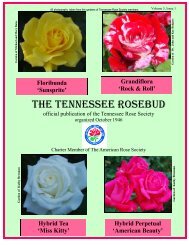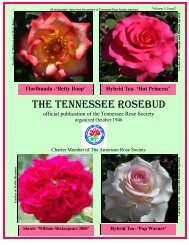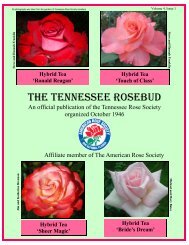THE TENNESSEE ROSEBUD - Tennessee Rose Society
THE TENNESSEE ROSEBUD - Tennessee Rose Society
THE TENNESSEE ROSEBUD - Tennessee Rose Society
Create successful ePaper yourself
Turn your PDF publications into a flip-book with our unique Google optimized e-Paper software.
Page 4 <strong>TENNESSEE</strong> <strong>ROSEBUD</strong><br />
GOOD BUGS---BAD BUGS<br />
By: Katherine Brennan, ARS Consulting Rosarian, kbrennan@tds.net<br />
As global temperatures rise, many insects are shifting their ranges northward. We will see along with our good bugs,<br />
more severe infestations from both local and exotic pests such as gypsy moths, bagworms and vine weevils. We will be<br />
dealing with pests we have never had in the garden. We will see them early in the spring and later in the fall. Some<br />
pests like whiteflies, aphids and spider mites flourish during heat waves. As climate change induces extreme weather<br />
patterns, our roses will become more stressed and less able to fend off pests and diseases.<br />
In May this year, I did a workshop at Meadow View Garden Center on “Diseases and Bugs in Our Gardens.” During my<br />
research and preparation for this talk, I learned there are more good bugs than there are bad bugs. Nature’s way is the<br />
good bugs are supposed to take care of the bad bugs. However, we both know that does not always happen.<br />
Below are lists of the most prominent good and bad bugs you will find in your garden. Their description will help you to<br />
properly identify them. Meanwhile, be on the lookout for “new” bugs and investigate how to safely and effectively manage<br />
them. Share your findings with fellow gardeners and good luck in your gardens!<br />
GOOD BUGS<br />
Aphidius wasp: 1/8” long and dark in color with transparent wings. They will rid your garden of all Aphids.<br />
Assassin bug: ½” long with broad bodies, sharp curved beak, bristly front legs, brown or black in color. They will rid<br />
your garden of aphids, most worms, beetles, earwigs and lace bugs.<br />
Big eyed bug: 1/6” long , oblong, wide-set eyes, gray, black or brown with clear wings. They will rid your garden of<br />
aphids, beetles, spider mites, thrips and whiteflies.<br />
Ground beetle: 1/8”-1½” long with shiny, hard-shelled bodies. Dark in color with large mandibles. They will rid your<br />
garden of caterpillars, potato beetle, cutworms slugs, snails, and tobacco bud worm.<br />
Hover fly: Looks like small wasps, black and yellow or white striped bodies. Hover like hummingbirds. ¼-1/2” long<br />
They are pollinators and will rid your garden of aphids, cabbage worms, mealy bugs and caterpillars.<br />
Lacewing: 1” long, slender, light green with large transparent wings. The larvae can consume up to 100 aphids per day.<br />
They will rid your garden of aphids, caterpillar eggs, cabbage worms, beetle larvae, corn earworms, whiteflies, spider<br />
mites and some scales and lace bugs.<br />
Ladybug: ¼” long with rounded bodies with black spots. Wings are orange to red with white on the thorax. Ladybugs<br />
rid your garden of aphids, beetle larvae, lace bugs scale, spider mites, whiteflies and eggs of other insects.<br />
Parasitic wasp: 1/32-1/2” long non-stinging wasps. Some have ovipositors that look like stingers but are not. They<br />
have slender, elongated antennae. Parasitic wasps rid your garden of aphids, beetle larvae, bagworms, cabbage worms,<br />
cutworms, leafminers, mealy bugs, sawfly, scale, tent caterpillars, tomato hornworm and whiteflies.<br />
Praying mantis: Can reach up to 5” long, shades of brown to green in color. Slender in body with large front legs.<br />
Heads can swivel 180 degrees with large compound eyes. They rid your garden of aphids, asparagus beetle, earwigs,<br />
leafhoppers and squash bugs.<br />
Spider: They come in all sizes and colors from drab brown to bright colors with various patterns. They have good hearing<br />
with an exceptional sense of smell and touch. Wolf spiders are very good for your garden. They will rid your garden<br />
of beetles, aphids, cutworms, fire ants, lace bugs, sawfly, spider mites, and squash bugs; but all spiders are predators.<br />
BAD BUGS<br />
Aphid: Tiny, 1/8” long with soft bodies, green, yellow, brown, red, gray or black.<br />
Bagworm: Caterpillars living inside a slender, silk bag (1 ½” to 2” long). Bags can be found on evergreen trees.<br />
Cabbageworm: Caterpillars are light green with faint yellow stripe down their side.<br />
Cucumber beetle: Striped beetles are yellow with 3 black stripes. Spotted beetles are greenish yellow with 11-12 black<br />
spots on the wing covers.<br />
Cutworm: 1 ½” long caterpillars curl into C shape, brown or gray in color; over-winter just below the soil<br />
surface.<br />
Earwig: 1/2-3/4” long and are dark brown in color with large curved rear pinchers.<br />
(Continued on page 5)





